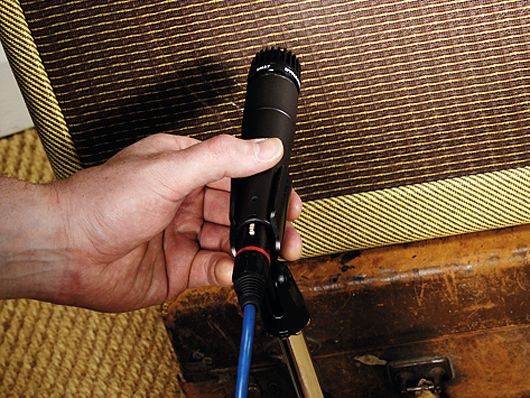 Image via musicradar.com
Image via musicradar.com
While perhaps not the most rewarding or necessary of mods that can be made to your home recording setup, this is an interesting one to start with as it's fairly simple, the gear involved is relatively cheap, and the mod consists of simplifying the design on something, as opposed to exchanging parts or adding to an existing design. I'm of course talking about the transformerless SM57 mod, or the "TapeOp" mod, as some refer to it (as this is where the first explicit version of this mod can be credited back to).
As many of you know (and if you don't, you've probably been living under a rock), the Shure SM57 may be the most prevalent mic in both recording and live sound. The old sort of adage goes that if you have an instrument and you don't know what to put on it, a 57 will probably get you by.
Despite the 57 having become many engineers' de facto go-to for guitars and snares and, to some extent, becoming a part of the "sound" of the instruments, it is by no means the pinnacle of instrument-microphone technology. Some people shun the "pinched" upper-mid-range character the 57 can sometimes bring to the table, especially when driven by certain sources. One way to potentially get around this is with the following mod.
What does the mod do?
This mod very simply removes the transformer that's wired in line between the capsule and the actual output of the microphone. The result is an extended low-end response, a reduction in the "pinch" that a 57 sometimes puts on a source, and improved transient response.
Now, it should also be noted that this mod is not necessarily designed to make your 57 "better"; its purpose is to change the characteristics of the mic to perhaps suit your needs. Sometimes the transient rounding of the transformer stage is a desired effect, and the reason you may be reaching for this mic in the first place, so if you're trying to make your mic "better," this is not the mod for you.
Side effects of this mod include a 10 to 12 dB drop in output volume, and allegedly, the mod makes the mic susceptible to damage from phantom power, though in practice it seems that this is more of a "potential in theory" for something to go wrong, rather than a guarantee. Nevertheless, keeping phantom power away from mics that don't need it is a good practice anyway.
How to do it
Onto the mod! This is an easy one to start with, as the SM57 has a very no-nonsense way of accessing the interior of the microphone.
- Simply twist and unscrew; no hidden screws, clips, epoxied parts, etc. After opening the mic, you'll see where the wires run from the mic element itself down into the body of the mic and into a giant glob of what looks similar to hot glue. At this point, it would be a good idea to make note of which lead is attached to which point of the capsule, as this will come in handy when we go to reassemble our transformerless 57.
- Now, to get that transformer out. Once you've desoldered the leads from the capsule itself and set that aside for safekeeping, you need to remove the XLR jack from the mic itself, which is as simple as disengaging the set screw for the jack and pulling it out.
- Soften the glue that's holding the transformer in place and remove it. The best way I've found to do this is with a heat gun, like you would use for shrink wrapping leads, etc. The alternative is to literally boil the microphone barrel on the stove, but this method is much more of a mess and far less elegant than the hair-dryer-on-steroids approach. Additionally, with the heat gun, you can soften the glue to the point where it just starts to release without turning into a disastrous mess. However, if you don't already have a heat gun, or for some reason investing in one would be a deal breaker financially, the pot-on-stove method will still get you to your end result.
- Tin and prepare new leads as mentioned in my previous article on soldering, and reattach these wires to pins two and three of the XLR jack. At this point, place the XLR jack back into the mic barrel and retrieve the mic capsule itself.
- Solder the lead that's coming from pin three of the XLR connector back to where the green wire came from, and pin two to where the yellow wire was soldered.
- At this point, you should be good to screw the entire mic assembly back together, and voila, you're now the proud owner of a transformerless SM57!
And for those who are infinitely more visual:
Aaron Staniulis is not only a freelance live sound and recording engineer, but also an accomplished musician, singer, and songwriter. He has spent equal time on both sides of the microphone working for and playing alongside everyone from local bar cover bands to major label recording artists, in venues stretching from tens to tens of thousands of people. Having seen both sides at all levels gives him the perfect perspective for shedding light on the "Angry Sound Guy." You can find out more about what he’s up to at aaronstaniulis.com.







